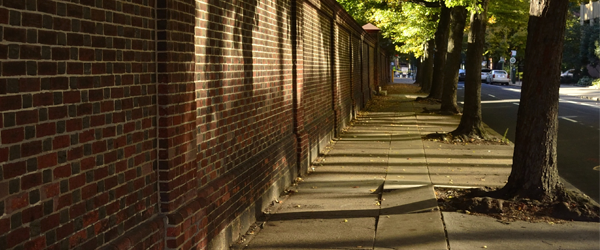
San Francisco was founded in 1776 and El Paso de Robles first established a post office in 1867, so both of the cities we operate offices in have a history to them and that brings with it old streets and often neglected, dangerous sidewalks (even neglected, dangerous roadways) in areas. In fact, looking for examples of images to use as broken sidewalks through the Internet made us realize how much easier it would be to go outside and snap a few photos to get better examples. In San Francisco, VisionZero is bringing attention to the “3 Es” of pedestrian safety: engineering, enforcement, and education. Engineering will of course take time and we must all keep that in mind, but education and enforcement are things we can all take part of each and every day to reduce pedestrian accidents.
We are all pedestrians each and every day, even if we only walk to and from our cars. Some people also ride bicycles or walk longer distances for health or to commute via public transportation. So taking notice of a dangerous sidewalk or roadway and reporting it can begin a process to prevent a future accident for anyone, even yourself if it’s on a route you travel frequently. Talking with a pedestrian accident lawyer is nearly always after an injury has occurred.
In Paso Robles, there is an online Action Request Form to use for any road-related repair request. The City asks this be used from everything from pot-hole fills to sidewalk repairs: http://www.prcity.com/government/departments/publicworks/action-general.asp
In San Francisco there is a mobile SF311 app to use for reporting road-related repairs as well as an online form for potholes and street/road defects. San Francisco uses separate forms for each item. In San Francisco, there is also a lot of information about getting your adjacent property sidewalk repaired here: http://sfpublicworks.org/sirp.
However, not all sidewalks belong to the City or County government. As pedestrian accident lawyers, we often must look at all addresses surrounding an accident or injury. California Streets and Highway Code section 5610 clearly states that a property owner specifically has a duty to maintain any sidewalk that fronts his or her property in a safe manner. Many cities have also adopted municipal ordinances consistent with California Streets and Highway Code section 5610, placing the burden of repair of sidewalks on the property owner. (E.g., Berk. Mun. Ord. § 16.04.010; San Luis Obispo Municipal Code § 12.16.020; Gonzales v. City of San Jose (2004) 125 Cal.App.4th 1127, 1137 [local ordinance expressly made landowners liable to members of public injured from unsafe conditions on abutting sidewalks].) In these situations, reporting the dangerous sidewalk is still the thoughtful thing to do. We have seen instances where the public entity has sent multiple notices to the property owner. There are also zoning and coding departments that you may call or write to if you know the address of the property owner and wish to escalate the matter to ensure notices are sent.
If you are beginning to review the sidewalks you encounter on a daily basis in your mind, think about the difference in elevation between the defects, breaks, or cracks. When reviewing cases as pedestrian accident attorneys, we’ve seen cases where differences of less than one inch have been considered “trivial” by the judge. Knowing that both San Francisco and Paso Robles are both kept very busy with road maintenance and repairs, you may find reporting defects in the sidewalk of less than a one-inch rise in elevation get placed at the bottom of the repair list. Your repair request may also be in a less-walked area and therefore a lower priority. In San Francisco, the Sidewalk Inspection and Repair Program (SIRP) inspects and repairs sidewalks throughout the City on a 25 year cycle prioritizing by a number of factors including pedestrian usage. Small defects can still be dangerous if unmarked and cause additional concerns for disabled pedestrians which we will address later, but if you look at the 12” defects in the sidewalks in Los Angeles, you’ll understand why some repairs might be first or last on the list.
Education and enforcement are two steps on the path to better pedestrian safety and the goal of eliminating traffic deaths within 10 years. Remember you play a big part in this!
